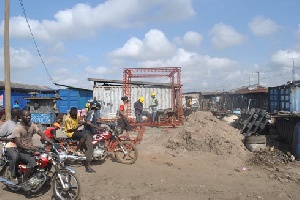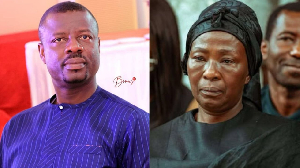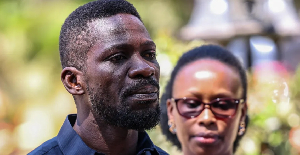By Yaw DK Osseo-Asare
There was a moment when I was thirteen-years-old. We had just departed Ghana, having stayed in a bungalow on the epic campus of the Kwame Nkrumah University of Science and Technology in Kumasi, a lush tree-filled landscape populated by early masterworks of African tropical modernism:
an architectural style of concrete near-brutalist large-format buildings with powerful structure, piercing windows and experimental form- and pattern-making. I remember Kumasi then as a vibrant swelling city that mesmerized me. There were large and historic buildings, built on the proud urban tradition of the Ashanti Kingdom.
But the state of civic and road infrastructure was in many places bad and in others non-existent. (Different time and place but similar space; see the road from Lomé to Cotonou.)
The image I have in my mind is of riding in the front seat of an old dilapidated taxi. The air was red, luminous and tangible from Harmattan and dust. Outside the window was a stream of in-process, often-ramshackle dwellings that seemed to pop up randomly in a kind of haphazard disarray of people striving on their own to work magic and create things out of the materials and resources they could access, their ingenuity and their hands.
The car had a hole in the floor through which I could see the road passing by beneath. It was raw, red earth, desiccated but filled with so many undulations and potholes that it appeared as if a Martian landscape.
We landed in Tokyo’s Narita Airport. Everything was so absolutely different it felt like a time-space warp; we had entered the future. A megacity urbanism of high-rise buildings and automated, illuminated or moving space, all engineered out of industrial materials. We got on a bullet train that seemed to me as if science fiction. Someone?—?maybe my sister??—?told me that it was a not driven by a human driver.
At that moment, when I was thirteen years old, I asked myself: How can such technological disparity exist between two human settlements on the same planet?
My teenage self concluded that the key mechanism must be innovation: the ways that cultural spaces practice technology. Over the next two decades, through practical experimentation with marginalized communities on four continents, I learned that “design is the multiplier”: iterative design process combined with prototyping + transdisciplinary collaboration + positive community participation coupled with social action = transformative impact on people’s lives.
Thanks to the universe, I found Prof. Arthur Loeb in his special attic studio workshop, which then occupied much of the top floor of Sever Hall in Harvard Yard: a sprawling space with high ceilings, wooden tables that doubled as workbenches, metal cabinets filled with all forms of miraculous objects the he together with his students and associates had fashioned over decades (now housed in the Arthur Loeb Design Science Teaching Collection at the Rhode Island School of Design).
Prof. Loeb taught classes like Visual Mathematics, Synergetics, and Design Science. After a doctorate in chemical physics, he was part of the research team for the pioneering Whirlwind computer at MIT and went on to explore spatial patterns in 2- 3- and 4-dimensions, together with collaborators such as M.C. Escher and R. Buckminster Fuller.
Like many other students before me, I found surprise and solace in his laboratory, where we learned concepts in practice, always using our hands as well our minds to discover characteristics of the universe and spatial reality that we never knew existed. In the introduction to his book Space Structures, Prof. Loeb offers:
“Space is not a vacuum, but has properties that impose powerful constraints on any structure that inhabits it. These constraints are independent of specific interactive forces, hence geometrical in nature.”
With his sponsorship, I received permission from Harvard’s then engineering department (now school) to design my own special concentration, which I called engineering design. This hack allowed me to make my own curriculum and with Prof. Loeb’s support I conducted a series of independent study courses in his lab, experimenting with design science.
I will remain forever thankful both for his setting me on a path (or rather, enabling me to enter a space where I could find my own path) and for the concomitant chance to graduate with my own made-up degree.
The expandable-collapsible cuboctahedron that I designed and prototyped for my thesis (“Dynamic Space: Towards a re-configurable architecture”) was an effort to test the validity of my claim that:
“The concept of static space that has served much of humanity since its inception is on the verge of extinction. Driven by the instantaneity of the microelectronic and information revolutions, modern society has become too unpredictable, and modern life too fast-paced, to be adequately contained within an architectural framework that is unchanging over time. Technological advances are such that previous barriers to the construction of flexible space structures are dissolving. Consequently, there are enormous potential and realizable benefits in developing a new grammar of space, grounded in the recognition that shapes do not have to be fixed.” (I never imagined at that point that this investigation would continue years later in Agbogbloshie.)
While I vibed with Harvard’s liberal arts education?—?taking classes on trees, Mesoamerican civilization, Islamic and world architecture, Russian science fiction and social justice?—?alongside physics, programming, electrical engineering, structures, mechanics and materials science?—?I felt oppressed by its academic structure founded on a Western tradition of ‘arts’ and ‘philosophy’ and ‘sciences’, despite effort to deconstruct and diversify.
After four years, I was exhausted and near-traumatized from constant battle with positions, attitudes, frames and viewpoints with which I did not agree. Swearing never to return, I went to India at the suggestion of my mentor, Alero Olympio, to study earth building at the Auroville Earth Institute (who later came from Tamil Nadu to Anam). Living in a deeply rooted cultural space?—?where people were self-aware of their culture’s ancient knowledge traditions that pre-date Western civilization?—?was a life-changing experience.
Then I spent a year in Ghana building a mud house out of cement-stabilized compressed earth blocks, where I interfaced daily with informal sector craftsmen and artisans who are the backbone of the building industry: carpenters, masons, tilers, glaziers, electricians, plumbers, painters and gardeners.
Many are migrants to Accra, some are day laborers with constrained social and economic opportunity, and many fewer are educated at polytechnic or university level. They are the makers who?—?against all odds and with often very limited resources?—?build everyday the future of Ghana and Africa.
When I then found myself back at Harvard again for an MArch at the Graduate School of Design, I loved everything?—?but was fiercely frustrated by what I felt to be a lack of diversity in the school’s pedagogy. GSD was then?—?even more so than today?—?largely corporate and starchitect-y.
For me the Western bias and focus on purely technical and formal questions?—?without fully engaging social or even political dimensions?—?was stifling. Designing highly stylized million dollar residences and art centers, large-scale infrastructure projects and billion dollar parametric smart cities seemed incongruous with the design challenges I had experienced on the ground in Ghana and India.
I spoke with my studio professor during her office hours, and she said: “Do what you believe and feel. You may feel that you are alone in your thinking, but through action you will find like-minded individuals who want to collaborate.”
Inspired by her words of wisdom, myself and a group of students made a call for more social responsibility in our design education and sketched out a four-year plan.
Three years later, the GSD hosted the SFI8 conference in partnership with Design Corps. A trans-disciplinary student steering committee workshopped ideas around design and social responsibility, even renaming the conference from Structures for Inclusion (the normal name of the SFI series) to Systems?—?to better reflect a flexible and fluid approach to social design.
Thanks to the help of people I have not thanked enough, students were able to congregate and exchange with leading social practitioners in architecture and design. It was one small but critical moment, alongside countless others at spaces of learning and making, where the capacity of many people to share their experiences and knowledge altogether at once amplifies both a network and its collective power.
Thanks to my advisers Marco Cenzatti and Teddy Cruz, the GSD let me graduate with a highly unconventional MArch thesis that studied piracy, shacks, kiosk culture, architecture as technology and network power. What I did not fully comprehend then was that I was calling for ephemeralization of the design of built environment into architecture robots and low-cost open-source digital information networks.
In a similar point of inflection but different way and scale, Ghana’s maker moment may beginning now. Increasingly, there appears to be a trend wherein Ghanaian (and African) youth are grasping their power to co-create reality:
engaging entrepreneurship, manipulating technology with their hands and exploring the potential of digital design and fabrication for custom on-demand micro-manufacturing.
New tools like virtual reality, 3D printers and scanners, laser cutters, CNC lathes, mills and routers?—?not to mention robotic exoskeletons?—?make possible rapid prototyping at an affordable price. Particularly when grouped together in a shared open community workshop, or makerspace.
In December 2012, Barcamp Accra hosted a breakout session on how to build Ghana’s maker movement. The action item for which the majority of participants offered support was upcycling e-waste: making local recycling more sustainable?—?by helping people make new things out of old electrical equipment and electronics.
Participants agreed that while it may take several years to realize, we should adopt and advance this cause; we started during that breakout session at Barcamp Accra by forming the Ghana Makers group on Facebook (now with over 1200 members). Today makers sub-regionally are pioneering new models:
Nicholas Tali runs the “Best Makers” WhatsApp group, with hundreds of incredible makers hacking Ghana’s future; Jorge Appiah and Anna Lowe are building a community of makers around Kumasi Hive; and Koffi Sénamé W??lab brainchild is advancing the Hub Cité project.
Around the same time, Yasmine Abbas and I developed design stellation as a participatory method for inducing inclusive urban innovation. We recognized that at the same time that the rise of IDEO-style design thinking failed to engage power dynamics (compared to participatory design), there was also something missing in the dominant discourse around smart cities, at least within architecture and urbanism circles.
Big Architecture celebrated then (just as it lauds today) the pervasive spread of technology infrastructure across urban spaces?—?despite chatter about the dangers of data, surveillance, voyeurism and the cloud?—?because of perceptions that it may afford architects an opening to gain power, by becoming a technology profession on one hand, and to create new and more immersive spaces and experiences by means of digital technology, on the other.
But virtually no one talked about the exploding social and ecological footprint (not just carbon emissions) produced by massively scaling up the number of electronic devices made and sold?—?all of which must eventually be recycled at the end of their life. We realized that current smart city models are actually pretty dumb?—?because they do not think intelligently about the environmental impact of planned obsolescence.
Sensing not only the urgent need to retool nodes and modes of informal sector scrapyards and recycling practices, but also their latent potential to remake reality through peer-to-peer learning and making, we co-founded the Agbogbloshie Makerspace Platform (AMP) to demonstrate the concept of design stellation in practice. We developed a Theory of Change roadmap, and have now completed the pilot project phase, thanks in part to a Rockefeller Foundation Centennial Innovation Challenge award.
Over 1500 youth from Africa, Europe and the United States have participated in this codesign process so far; their hard work, dedication, creativity and collaborative vision have made this all possible.
Sometimes things worth doing take a long time. When I think back to that day when I landed in Japan and tried to make sense of how different the technology of space felt, relative to Ghana, I did not know about things like “open innovation”, “design stellation”, “STEAM”, or “makers”.
But now I realize this is the form of collaborative co-creation?—?itself nothing new to Africa?—?that can have a radically positive impact on the ground across the continent. Technology triangulates knowledge, tools and skills; it should be shared, democratic and available to everyone.
Today it is exciting because AMP has moved from an idea to reality. We are now partnering with the Impact Hub network and Siemens Stifling to install a pilot makerspace at Impact Hub Accra—a second prototype to join the first in Agbogbloshie, building a model of mobile (deployable) plug-in makerspaces with modular and intercoordinated tools and equipment for digital design and fabrication.
If you are interested in Africa’s techno-future, and want to see young people empowered to make the technology that can remake the continent before its too late?—?please consider taking 30 seconds to support AMP’s Thunderclap campaign. It is not a pledge to donate money; it just means you will help share the AMP story on 26 September 2016.
Opinions of Wednesday, 21 September 2016
Columnist: Yaw DK Osseo-Asare













